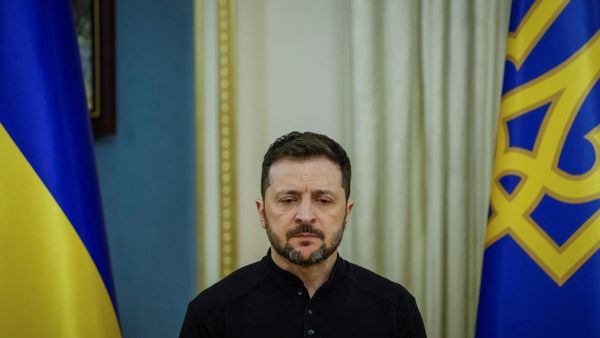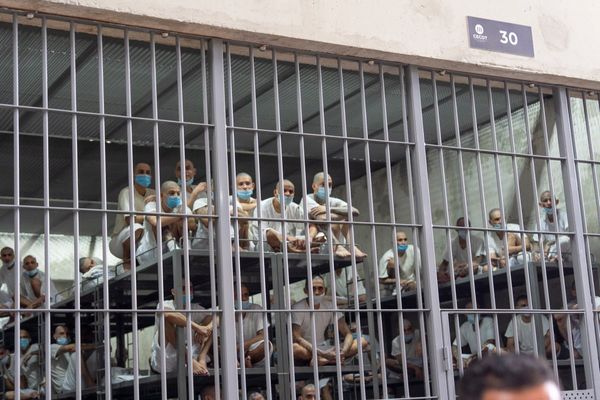
The sculptor Laurence Broderick, who has died aged 88, was known for a single work, although that work was both widely loved and hard to miss. Standing nearly three metres high and weighing seven tonnes, The Guardian, known popularly as The Bull, has stood in Birmingham’s Bullring shopping centre since 2003. In that time, it has become the city’s mascot, a symbol of its bullishness.
Modelled on a Hereford bull, the massive bronze is the favourite subject of camera-toting tourists and a meeting place for local shoppers. From time to time, it is dressed in seasonal costume: when the Rothesay Classic at Edgbaston is taking place, the bull appears in tennis whites; at Christmas, it sports a red nose; when temperatures fall, it is given its own woolly jumper. When, in 2006, vandals scratched their initials into its flank, Brummies were outraged. Broderick was overjoyed by the public response to his creation: “It’s doing really what I wanted it to do. It’s uniting the people of Birmingham.”
His sculpture even spawned another bull, a vast animatronic creature dubbed Ozzy, made to mark the city’s hosting of the 2022 Commonwealth Games. And smaller bronze variants of The Guardian, editioned by Broderick, have sold all over the world, most popularly in China.
Fame came late to the artist, who was nearing 70 when he won the Birmingham commission. Before that, he had made rather smaller sculptures, particularly of otters. “It doesn’t matter where I exhibit,” Broderick mused. “People always buy them.”
It was an otter that allowed him to move into sculpture full time. For the 20 years to 1981, he had taught art at Haberdashers’ Aske’s boys’ school, in Elstree, Hertfordshire; among his pupils there was the future Formula One driver Damon Hill. On a family holiday to the Isle of Skye in 1978, Broderick had been so entranced by a wild otter he saw swimming in the sea that he carved it in local stone. This led to the offer of a one-man show on the island three years later, which sold out.
At 46, he could finally afford to give up teaching. As a mark of his gratitude to the animal, Broderick became joint president of the International Otter Survival Fund, based on Skye, and he returned to the island each summer for 26 years to work in his studio there.
His interest in wildlife he owed to childhood asthma. Born in Bristol to Jack and Cynthia Broderick, Laurence was a sickly child. Hoping that sea air would be good for his lungs, his parents sent him to Bembridge school on the Isle of Wight, an outdoorsy place in a hundred coastal acres where students were encouraged to climb cliffs and bathe in the Channel. From there, from 1952 to 1957, he went to the Regent Street Polytechnic (now the University of Westminster), where he was taught sculpture by Geoffrey Deeley, earlier the teacher of Sir Anthony Caro. After this, he went on to the Hammersmith School of Art (now West London College) until 1961.
By then, Broderick was working as a schoolmaster, supplementing his income with freelance book illustrating. The father of a growing family, he moved to the Cambridgeshire village of Waresley, this being, as his son Graeham said, the “first place when he drove north from London where he could afford a house”. He would stay there for 60 years.
For the two decades after his sell-out show in Skye, Broderick worked mostly on small-scale sculptures, often made in materials with evocative British names: Portsoy marble, Polyphant soapstone, Hopton Wood limestone. (He had also once sculpted in snow, as part of a British team at the Quebec Winter Carnival in 1983.)
These he carved alla prima, taking his chisel directly to the figure without preliminary drawings or models. The result was a fluidity and sinuous tension that lent itself well to fish, cats, birds and, pre-eminently, otters. It was Broderick’s Leaping Salmon, in a pond in Chester business park, that caught the eye of the Bullring’s developers.
His work was shown at the Royal Academy Summer Exhibition and included in shows of the Society of Wildlife Artists. Broderick also produced rather less successful sculptures of nude women, as well as powerful bronze portraits of, among others, the transplant surgeon Sir Roy Calne, for Addenbrooke’s hospital, Cambridge.
It was his twice-life-sized bronze bull, though, that brought him fame. His first instinct, he told the website Birmingham Live in 2015, had been to turn down the commission. “I was more interested in doing otters,” Broderick recalled. He relented at the persuading of his family. The project accepted, he set off to draw bulls on nearby Cambridgeshire farms, although these annoyed him by licking his sketchpad.
The Guardian was an immediate success, with 270,000 people attending its unveiling, and in time it became one of the most photographed landmarks in Britain. In 2015, the Independent newspaper included Broderick’s bronze bull in a list of 10 top pieces of public art worldwide, along with the Statue of Liberty and Michelangelo’s David.
In 1963 Broderick married Ingrid Bohne, from Germany, whom he had met when she was an au pair in London. They had three sons, of whom the youngest, Oliver, died in 2019.
He is survived by Ingrid, and their sons Graeham and Roger, and four grandchildren.
• Laurence Broderick, sculptor, born 18 June 1935; died 18 April 2024







